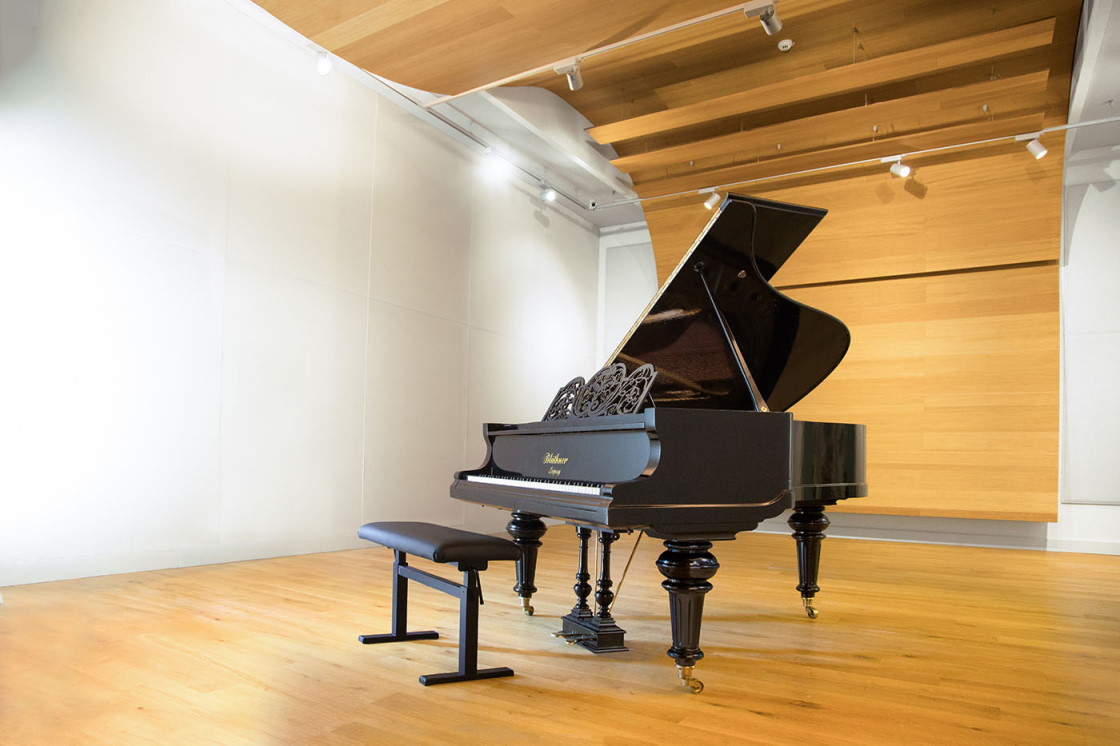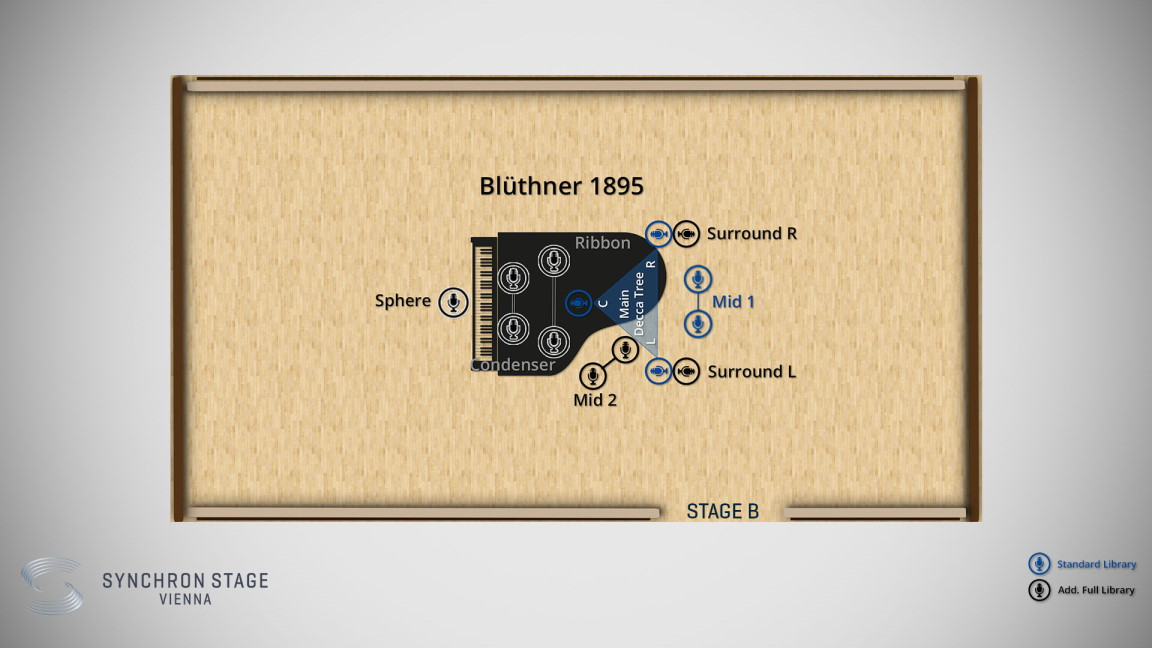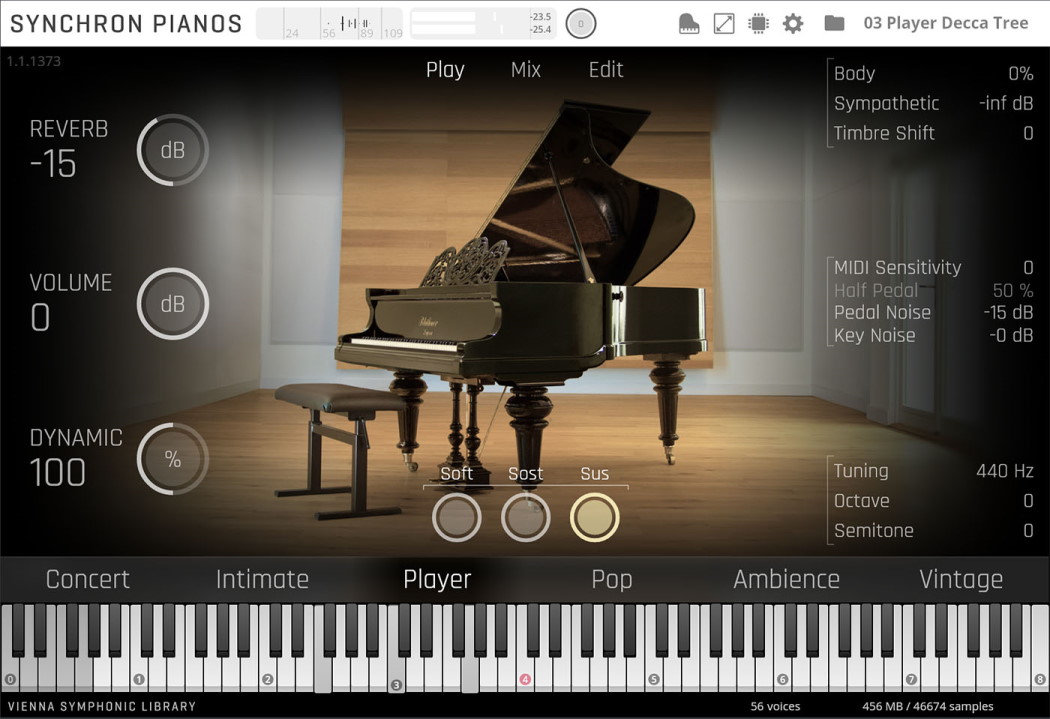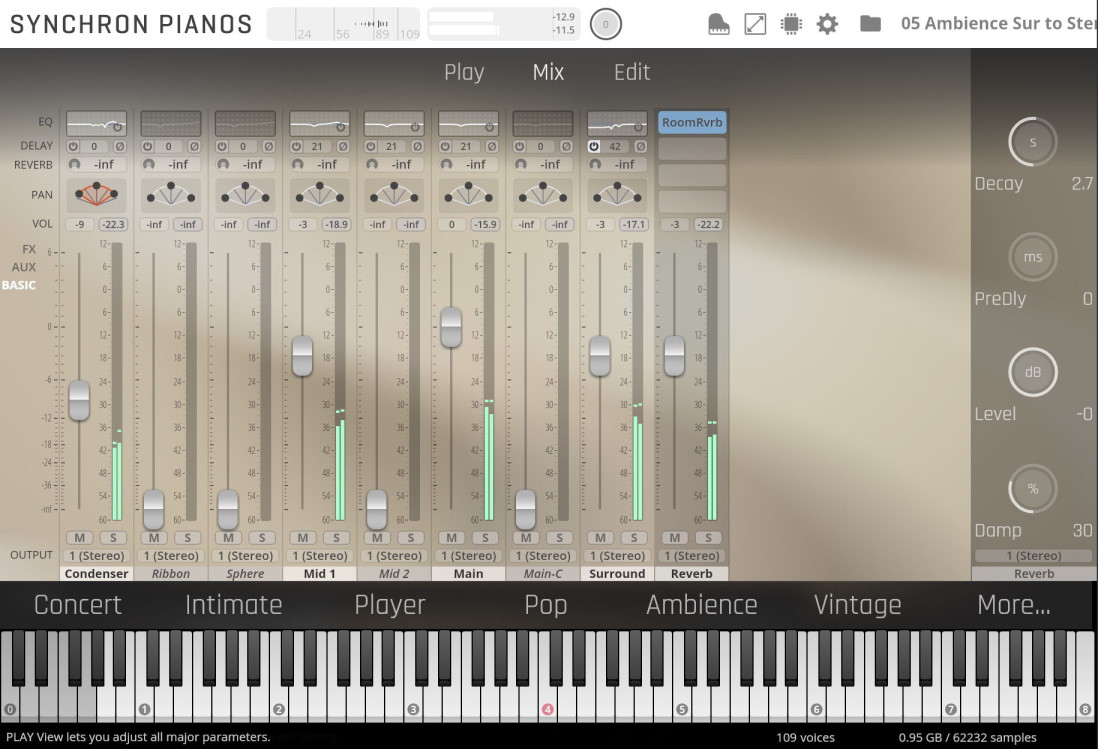Blüthner 1895
Introduction
This exceptional grand piano was built in 1895 by the famous Julius Blüthner Pianofortefabrik of Leipzig. It was acquired by Synchron Stage Vienna after having been lovingly restored by master piano builder Bernhard Balas from Vienna.
The 193 cm professional scale instrument is equipped with Blüthner's specially developed and patented Aliquot system that uses additional dampened strings positioned above the conventional strings of the treble register, which are not struck by the hammers but resonate sympathetically. This fourth set of strings enhances the overtones, providing a velvety, organic shimmer and giving the instrument a particularly lyrical "singing" quality. In addition, the strings are unusually long and thin, stretched to an enormous string tension of 20 tons, which helps define the instrument's specific sound. In combination with its soft hammers the Blüthner grand produces a clear, yet warm and soft timbre that is superior to many modern instruments in its variety of tonal colors.

Composers such as Debussy, Brahms, Mahler, Bartók, Liszt, Tchaikowsky, Shostakowitch and Rachmaninov created their works on a Blüthner grand. Famously, Paul McCartney played a Blüthner concert grand when recording "Let It Be" for the film of the same title in 1969.
Standard and Extended Library
The instrument was recorded using 8 microphone positions. The Standard Library includes 4 of these sections, allowing you to integrate instruments recorded with a stereo Decca tree into your projects using our new Synchron Player software. Adding the Extended Library and thus getting the Full Library expands your possibilities to 5.1 surround and Auro 3D 9.1.
Microphone positions

Standard Library
Condenser - Close 1 (Sennheiser MKH 8040)
- "ORTF" setup with a pair of Sennheiser MKH 8040, positioned as closely as possible over the hammer area. Ideal for producing the typical "pop piano" sound.
Mid 1 (Sennheiser MKH 800)
- "ORTF" setup with a pair of Sennheiser MKH 800 mics for a hard and focused sound. wide, warm yet bright and centered sound.
Main/Room Mic – Decca Tree Stereo (L/R)
Main/Room Mic – Decca Tree Mono (Center)
- Decca Tree array (L-C-R) with three DPA 4006 mics. These very neutral microphones captured even the smallest detail of Synchron Stage Vienna's Stage B. Used in a stereo mix, you can easily hear where the piano is placed. In a surround setup, the Decca tree microphones will be the feed for your front L-R speakers.
Extended Library
Even if you're not using a surround setup, you get more ambience variation and spatial depth out of the Full Library by adding the room microphones' signals to your stereo mix.
Ribbon - Close 2 (Coles 4038)
- "A/B" setup with two ribbon figure-eight capsules of a Coles 4038 mic, for a fast, direct, and vintage sound.
Sphere - Close 3 (Schoeps KFM 6 Sphere)
- The KFM 6 Sphere setup aims at a perfect representation of the player's listening position.
Mid 2 (Sennheiser MKH 40)
- "ORTF" setup with a pair of Sennheiser MKH 40 mics for a wider and warmer sound than the MID 1 Position.
Main Surround – Stereo (L/R)
- Wide A-B stereo setup with two DPA4011 cardioid microphones. In a surround setup, these microphones would be used for your rear speakers.
The instrument Presets also include different mixer presets. By default the classic room mixes are loaded which include the Standard Library microphone positions. These are balanced in the stereo field to represent the respective instrument's position in the Synchron Stage set-up.
Immersive Sound and Auro 3D
Auro 3D is an immersive audio technology that allows for three-dimensional sound perception. The Belgian company Auro Technologies developed this technology based on a special speaker configuration, adding four additional speakers to a 5.1 surround configuration. These speakers (so-called "Heights'') are situated above the front and surround speakers and generate acoustic reflections that are perceived naturally due to the fact that sounds originate from around as well as from above the listener. Thanks to the comprehensive selection of discrete audio channels with the Full Library of Synchron Percussion I you may mix your instruments in Auro 3D as well as in Dolby Atmos.
About Pitch
For designating pitch, the Vienna Symphonic Library uses International Pitch Notation (IPN), which was agreed upon internationally under the auspices of the Acoustical Society of America. In this system the international standard of A=440 Hz is called A4 and middle C is C4. All pitches are written as capital letters, their respective octave being indicated by a number next to it. The lowest C on the piano is C1 (the A below that is A0), etc.
Walkthrough Videos
About this piano
Vienna Symphonic Library's Blüthner 1895 grand piano was recorded at Stage B of Synchron Stage Vienna. This beautiful 69 m2 (739 sq ft.) live room with a 3.5 to 4.5 m (11.5 – 14.75 ft) height features a controlled acoustic environment with less ambience than the large main hall (Stage A).
While beautifully restored, this Blüthner 1895 was recorded "as is", with all the charm and peculiarities that give a seasoned instrument its character. Its virtual recreation is extremely versatile and well suited for soloists looking for a slightly different, personal piano sound. The Blüthner lends itself extremely well to song accompaniments and chamber music settings, as well as to pop songs and ballads where other concert grands sound too large and obtrusive. Presets like "Intimate" or "Vintage" bring out this special quality even more.
Key Features
- Refurbished 193 cm (6-foot-4) grand piano with patented Aliquot stringing
- Glorious example of Blüthner's legendary "golden tone"
- Recorded at Stage B of Synchron Stage Vienna
- Advanced Release Sample Technology
- Multiple Microphone Positions – for a multitude of timbral variations
- Pre-configured Main Presets: "Concert", "Intimate", "Player", "Pop", "Ambience", "Vintage"
- FX Presets for enhanced, warped or mysterious piano sounds
- Soft (una corda), sostenuto, sustain pedals
- Half-pedalling and re-pedalling
- Sympathetic resonance
- Body resonance

Advanced Release Sample Technology
To capture the Blüthner 1895 with all its subtleties, our engineers developed a highly precise motion-control system based on a solenoid that controls a noise-free "robot finger". The micro-controller moves the finger with super-human precision, providing flexible curvatures for down-strokes and release movements, the latter corresponding with the preceding note length and various release speeds.
Customize Your Personal Sound
In addition to the multitude of options from mixing various microphone signals, the Blüthner 1895 comes with the free Vienna Synchron Pianos Software that offers multiple options for shaping your sound and your playing experience. Hosting a high-performance playback engine, the software provides a full-blown mixer with a broad range of effects such as EQ, compressor, saturator, algorithmic reverb, delay, chorus, flanger, rotary, and many more. Change the volume of body resonances, sympathetic strings and pedal noises right in the main Play window. In the Edit window you may even adjust EQ, volume, tuning, dynamic range, etc. for each individual key!

Included Presets
In the browser window of the Synchron Pianos player you may select from three general preset categories
Decca Tree Multi Mic (Standard Library)
The classic sound of a Decca tree stereo recording features a more slender sound with less diffusion compared to the "Room Mix" Presets.
Surround to Stereo Downmix (Full Library)
These presets include all available room microphones with various runtime delays, creating more diversity in the perception of room depth.
Surround (Full Library)
Designed to send the microphone signals to your available surround channels.
FX
Our specially designed FX Presets offer you an easy way to achieve more drastic changes to the sound of your Bluthner, and elevate it out of its 1895 origin into pop and electronic spheres – or make it sound like an even older harpsichord!
Here's a list of the available FX Presets:
- Evolution: A spacious sound with a synced delay.
- Diamonds in the Night: Fragile chorus piano with a magical aftermath.
- Reality Check: Discreet 80ies piano, great for accompaniment.
- Stadium: Bigger than life, with a slapback echo.
- Time Warp: Dreamy keys with intense use of delays.
- Wormhole: Reverse FX in combination with delays create a Bluthner from another galaxy.
- Magic Doors: Distant E-piano with a singing tone.
- Blunt but Friendly: A harmless but useful flat piano sound.
- Fuzzmaster: Slightly distorted stage piano.
- Harpsichord: A classic harpsichord sound.
- Candy Cotton: A muffled piano, for reflective moments.
- Donnie: Dark piano in a large hall.
- Glittering Clouds: Modified attacks with delays in a shiny room.
- High and Mighty: Singing, hovering piano sound with a very light sonic appearance.
- Morphology: Shimmering FX on a shiny piano sound.
- From a Distance: A warm piano sound from far away.
- Megatrump: Thinned-out pop piano with a great level of built-in distortion.
- Pierce: Shivering piano in a beautiful hall.
Character Presets
The Synchron Pianos player interface offers instant and direct access to seven pre-configured character presets.
1. Concert
- Character: The most flexible preset of the Blüthner piano.
- Perspective: Conductor, with the instrument positioned in the center.
- Recommendation: Ideal placement in your orchestra, compatible with all Synchron Series products.
2. Intimate
- Character: Dark, warm and close sound. Added plate reverb to enrich the sound.
- Perspective: Player, centered
- Recommendation: For intimate ballads.
3. Player
- Character: Immediate response with full stereo width of the keyboard. Enjoy the natural response of Synchron Stage Vienna's Stage B, with added Room Reverb.
- Perspective: Player, centered
- Recommendation: Ideal recording preset for pianists. The perfect imitation of the player's position, with more sonic accuracy than the intimate preset.
4. Pop
- Character: Powerful and assertive, with added compression in the close microphones. Accentuated high frequencies and MIDI sensitivity. Room Reverb with a short reverb. Decca Main microphones are delayed to create a short slap-back sound.
- Perspective: Player, centered
- Recommendation: For live performances and in a band context.
5. Ambience
- Character: A spacious sound with a lot of room reverb to add to the spacious impression.
- Perspective: Conductor, piano centered.
- Recommendation: For film scores, soaring piano melodies and a powerful piano sound in the background.
6. Vintage
- Character: Narrowed stereo image with a phasing effect and a delayed Plate Reverb, sent through a cabinet speaker.
- Perspective: Conductor, piano centered.
- Recommendation: Great for intimate accompaniment and a "different" sound.